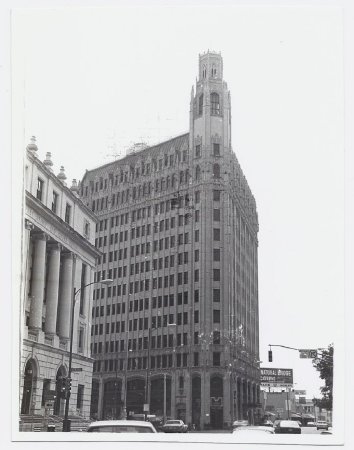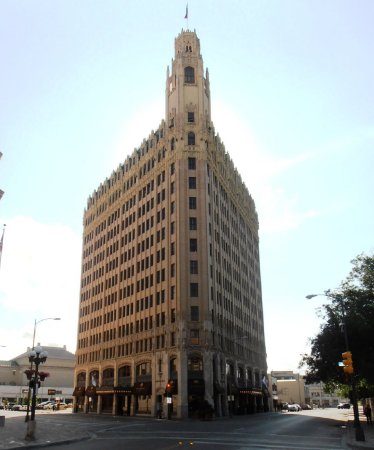History:
Post-flood construction downtown was booming and included: the exotic Aztec (1926) and Majestic (1929) theaters; public works projects, like Municipal Auditorium (1926) and the river cutoff channel (1929-1930); and new skyscrapers, such as the Medical Arts Building (1926), Smith-Young Tower (1929), and Nix Building (1929).
Local architect Ralph Cameron designed the Gothic Revival Medical Arts Building to fit on the wedge-shaped piece of land bounded by E. Houston, Ave. E, and Third Streets at the northeast corner of Alamo Plaza. The thirteen-story building, which opened in 1926, originally housed medical offices and a hospital. The building was remodeled for office use in 1976 and converted into the Emily Morgan Hotel in 1985.
Local architect Ralph Cameron designed the Gothic Revival Medical Arts Building to fit on the wedge-shaped piece of land bounded by E. Houston, Ave. E, and Third Streets at the northeast corner of Alamo Plaza. The thirteen-story building, which opened in 1926, originally housed medical offices and a hospital. The building was remodeled for office use in 1976 and converted into the Emily Morgan Hotel in 1985.
About this Image:
1.) Looking northeast at the Medical Arts Building from the corner of E. Houston Street and Ave E. Notice the ornate stone and terracotta ornament.
2.) Although the building features carved faces, it does not have any true gargoyles. Carved figures that seem to display medical maladies can be found hunched in the upper corners of the ornate ground floor windows on either side of the Houston Street corner.
2.) Although the building features carved faces, it does not have any true gargoyles. Carved figures that seem to display medical maladies can be found hunched in the upper corners of the ornate ground floor windows on either side of the Houston Street corner.
To Learn More:
Credit:
Courtesy of San Antonio Conservation Society Foundation


